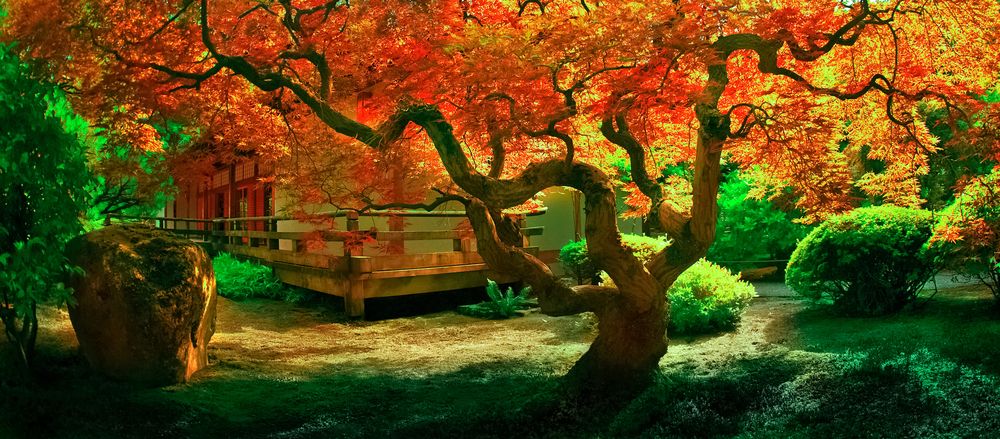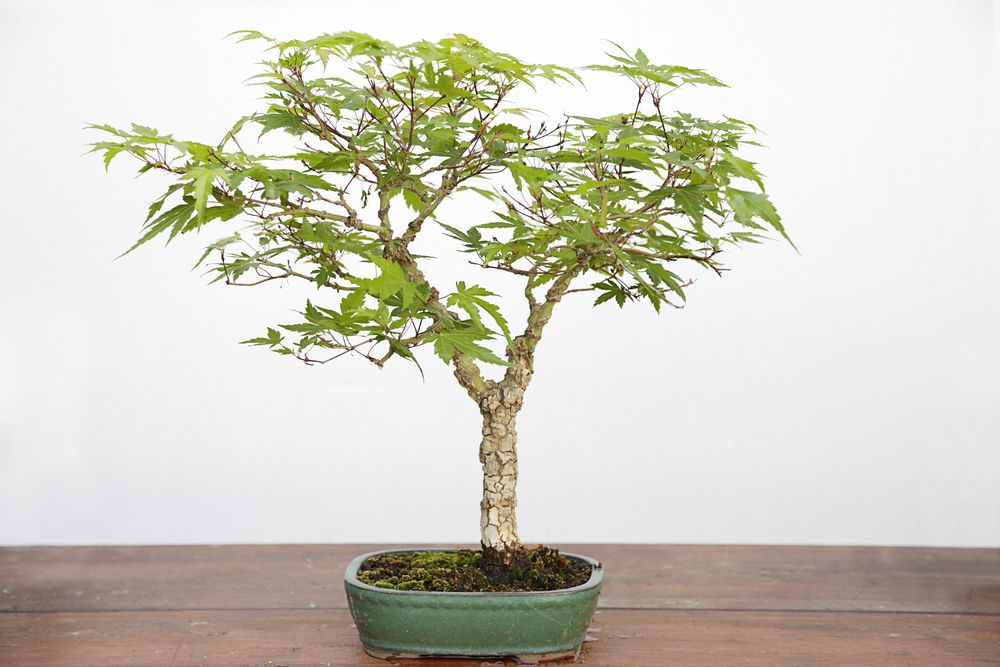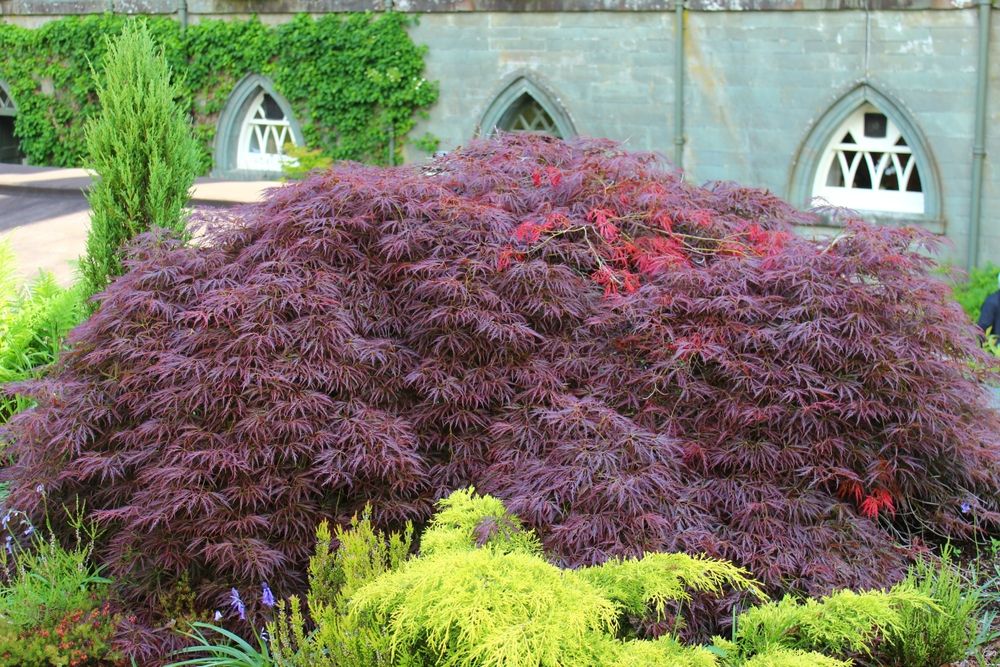
The Japanese Maple Bonsai - Growing & Care Instructions
Published: 13/12/2023 | Updated: 14/12/2023


Bonsai is the traditional Japanese art of growing little, decorative trees in pots to make them look like they would at full size.
Because of their attractive, vibrant fall foliage and low maintenance requirements, Japanese maples are among the most popular trees for bonsai. These trees mature into moderately-sized shrubs with a moderate growth habit. Layered branches and characteristic palm-shaped leaves characterize the widely drooping crown.
Japanese maple bonsai are ideal bonsai tools for novice growers because they don't demand as much expertise as other types of bonsai.
The Japanese maple bonsai has several advantages, one of which is that it does not need as much direct sunlight as other types of bonsai. The procedures used in training bonsai trees are perfectly suited to the fine, delicate branches.

The General Japanese Maple Bonsai Know-How
When properly cared for, Japanese maple bonsai can flourish in both novice and expert hands. They develop at a slow-growing steady pace, making them amenable to regular pruning and wiring for shaping.
While the leaves are still on the tree the summer is the best time to wire a Japanese maple bonsai, and the wires should be removed after no more than six months.
Japanese maples benefit greatly from being wired because their branches are so malleable and adaptable. Take your time and don't rush the wiring process; you don't want to hurt the tree.
Soil
Bonsai grown from Japanese maple trees need nutrient-rich soil with a pH of 5.5 to 6.5 that drains well.
Bonsai soil mixes are available for purchase, and they are highly recommended for growing bonsai trees.
Fertilizer
Fertilizing Japanese maple bonsai consistently promotes healthy new growth.
Organic bonsai fertilizer or liquid fertilizer should be used every other week during the growing season in the spring and summer of Japanese maple bonsai. Reduce the frequency of feedings and consider switching to a nitrogen-free fertilizer in the autumn.
Feeding a Japanese maple bonsai too soon after repotting will shock the plant's sensitive roots, so wait a few weeks.
Watering
Even moisture is ideal for bonsai trees of the Acer palmatum species. The key word here is "evenly," so make sure not to over or underwater it. Allowing the soil to dry completely before pouring a bonsai tree's soil is a good idea (but not the bale). Do not allow the Japanese maple to dry out completely, even during the winter (wait for a frost-free period to pour throughout the winter).
To prevent waterlogging, bonsai soil should be very porous to both water and air. It is possible to irrigate the soil multiple times on hot summer days if it is evenly moist and drains effectively. The surplus liquid can easily drain away.
Plenty of water is lost from the fine leaves during the hot summer months. Too much to pour under normal circumstances, and often too much for the bonsai container to hold. It can cause the tips of the leaves to dry out. Because of this, a Japanese maple bonsai should be kept in a slightly shaded and sheltered location during the summer months.
Propagation
Because of the long period needed to produce anything approximating a tree from maple seeds, propagating your Japanese maple is best accomplished through the use of cuttings. In early to mid-summer, when the new growth is just starting to harden, collect softwood cuttings that are four to six inches in length. The success rate for many cultivars is low because they are difficult to root. Take off all but the very top leaves. Evidence suggests that bottom heat improves the success rate of cuts. Maintaining shady conditions will promote root development.
Sunlight
When it comes to sunshine, Japanese maple bonsai don't have the same requirements as other types of bonsai. As a result, they thrive in partially shaded gardens.
They thrive in places that receive direct sunlight in the morning and evening and dappled sunlight during the day. When temperatures rise throughout the summer, leaves can easily get scorched by direct sunshine.
Humidity & Temperature
Japanese maple bonsai, like most bonsai trees, thrive outside and poorly in closed environments.
While they originated in Japan, they have proven to be highly adaptable to the climates of the Americas, Europe, China, and Korea. Although these trees can survive brief periods of subfreezing weather, they still need protection from the worst of winter.
Pruning & Training
Pruning in late spring to midsummer will lead to masses of new shoots from the internodes, so be sure to pinch out the tips of new shoots when one or two pairs of leaves have developed entirely in early spring to keep the desired shape.
Remove any new growth that has very lengthy internodes. Maples have a propensity to back bud easily, producing shots from both old and young wood, making them amenable to severe pruning virtually year-round. If you shape them incorrectly, you run the danger of losing a branch because they back bud largely from internodes, not from the tips of individual leaves.
Almost any time of year is fine for wiring, but early spring is best because the tree's structure is seen before the buds form. The improved branch setting is because the tree is about to put on growth.
Wiring during this rapid growth period requires extra caution to avoid damaging the bark and branch. Wiring in the fall requires extra care because the branches won't mend until spring.
Raffia can be used to shield the branches' tender bark from damage. In six months, you'll need to rewire (or sooner if you see the wire nibbling). Avoid wiring during the winter months since fragile branches are more likely to break.
Broom, casual upright, group plantings, raft, twin trunk, clump, and weeping are just some of the bonsai styles that work well with this species.
Styling
The Japanese maple is one of the most sought-after tree species for bonsai. You can train a bonsai to develop a densely branched crown by cutting and pinching it regularly. The robust root development can be put to use in stunning root methods. And the tiny, vividly colored leaves make a beautiful accent. Particularly in the wintertime.
Repotting
Soil that drains well, is slightly acidic and contains sand is ideal for Sharp's Pygmy Maple. Some organic matter should be added, but not so much that the tree becomes soggy. Since it has a low pH, chopped sphagnum moss is an excellent soil amendment. Trees should be repotted annually or every other year until they reach the age of ten, and then every two to three years thereafter.
When repotting, don't take out more than half the tree's root system, and even less for an older, more established tree. Although Japanese maples have naturally shallow root systems and adapt well to shallow bonsai dishes, caution must be given to avoid excessively trimming back the roots out of impatience to have the tree in the "perfect" container.
Overwintering
As an outdoor bonsai, the Japanese maple can withstand temperatures well below freezing. A windbreak (such as an unheated greenhouse, a foil tent, or a protected outdoor nook) is necessary to protect the delicate leaves and branches from drying out. When there is no danger of frost, you can safely check the soil's moisture level and pour if needed.
Pests & Diseases
When healthy, Japanese maples rarely get infected, but when they're under stress, aphids and scale can start to take over. In the spring, aphids can distort the leaves of young plants. Spider mites, weevils, and bark beetles can also infest a sick tree.
To combat them, simply spray the entire leaf zone with a solution of 1 tsp of dish soap per 1 quart of warm water until runoff occurs. Use lukewarm water to thoroughly rinse. Caterpillars in the area can quickly defoliate a tree, so keep an eye out for them. Caterpillars can be easily dealt with by removing them by hand and giving them a sharp stomp with your heel, which may sound unpleasant but is quite effective.
Root rot due to fungal diseases caused by overwatering is another risk. Leaf scorch is a prevalent issue with Japanese Maples even though it is not a disease. It happens when leaf transpiration exceeds leaf uptake of water. Too much heat from the sun, late or early frosts, drought, drying winds, or an excess of minerals and salts in the soil from improper pH or over-fertilization can all contribute to this problem.
Bonsai Pots
Glazed bonsai pots are ideal for Japanese maple bonsai due to their vivid foliage. As a member of the hardy bonsai family, Japanese maples make excellent candidates for frost-proof, artisanal bonsai containers. Our experience has shown us that cheap bonsai pots (intended for indoor bonsai) are remarkably resistant to frost. However, we cannot promise that these containers will survive frost.
Unglazed bonsai pots are less ideal than glazed ones. If unglazed, choose a pale shade (like gray). Large bonsai can be housed in containers found in the section labeled Large bonsai pots.
An oval bonsai pot is a great choice for a Japanese maple bonsai because of the tree's rounded top. In most cases, rectangular planters are inappropriate. We would choose a rectangular bonsai pot with slightly rounded corners. In some cases, a flat, spherical bonsai pot will do as well. Especially because the root ball of a Japanese maple bonsai tends to be relatively thin.
A Japanese maple should not be kept in an apartment, therefore drip trays are unnecessary.
Plastic bonsai containers are ideal for developing bonsai. When paired with the typically gray trunk of a Japanese maple bonsai, the pots' dark brown hue looks out of place. In contrast to ceramic containers, these plastic ones are impervious to cold, and UV light, and cost significantly less. Plastic plant containers are ideal for seedlings that are two to three years old.

Types of Japanese Maple for Bonsai Trees
Many species of Japanese maple lend themselves well to bonsai care and development. The following are examples of some of the most typical and often-used bonsai species:
-
Acer palmatum ‘Shishigashira’:
The 'Shishigashira' variety is known for its slow but steady growth to a height of 7-15 feet. Bright green, palmate leaves (up to 2 inches long) with 5 to 7 lobes grow in whorls along the stems. Young trees often have scant foliage. In the autumn, the leaves take on flamboyant hues of gold and scarlet.
-
Acer palmatum ‘Arakawa':
'Arakawa' (Palmatum Group) is a hardy, upright tree that can reach a height of 20-25 feet in its mature state, but usually reaches a height of 10-14 feet in its first decade. In the spring and summer, palmate leaves are green, but by autumn they have turned a golden yellow.
-
Acer palmatum ‘Katsura’:
The 'Katsura' variety of A. palmatum has short leaves that are greenish-yellow with orange-red edges. When planted in the ground, it has the potential to reach a height of 25 feet, although it grows very slowly. It grows tall and straight, and it starts to put out leaves in early spring.
-
Acer palmatum ‘Deshojo’:
A. palmatum 'Deshojo' has compactly branched plants. Standard cultivation keeps it under nine feet tall, therefore it's also a dwarf. The red leaves stand out.
-
Acer palmatum ‘Seigen’:
Seigen is a type of red Maple that is rarely encountered. Unfazed by temperatures as low as -10 degrees Celsius. Give some relief from the hot sun. It's best to keep the tender plants in a protected area, out of the strong wind.
Tips for Caring for a Bonsai Tree
You should transplant it into a larger container every three years or so or replace the substrate entirely. Substrates tend to compress and lose all of their nutritional content over time. You'll have to uproot the plant, get rid of the substrate, and trim the roots. After that, replant in a pot that's the same size or slightly larger.
Fertilization is critical for nutrition. Because there is so little space for nutrients in the substrate, you will need organic fertilizers to provide all of their food and continue to do so frequently.
Last, but not least, remember to turn your tree. A bonsai should be viewed from a specific angle, yet you still don't want the tree to be crooked. Try switching roles every so often.


